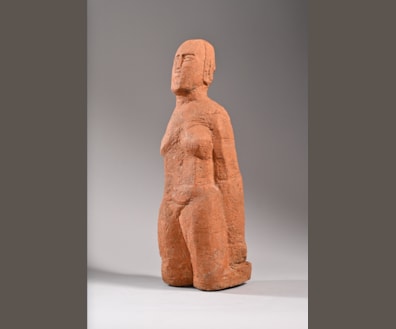
Georges GUYOT
( 1885 - 1973 )
PANTHÈRE S’ÉTIRANT
H : 45,5 cm, L : 96 cm, D : 19,3 cm
Lifetime cast signed "G L Guyot", mark by "Jallot Editeur d'Art", "Cire perdue.Meroni Radice.Paris" seal.
Cats between 1921 and 1929
Provenance : Myron T. Herrick (1854-1929).
Detailed Description
sketches of the bears he saw at the Jardin des Plantes. His father regularly accompanied him to the
Louvre, where he was truly impressed by Barye’s Lion au serpent .
In 1904, he enlisted in the army, with the 39th Infantry in Rouen. He attended evening classes at the École des Beaux-Arts by M. Lelong. Lelong installed a ceramic kiln and asked Guyot to try out a clay bear. The piece, submitted to the Salon jury, was accepted. From 1906 onwards, he exhibited every year at the Salon, showing animals of a more realistic style. Around 1909, he decided to devote himself entirely to sculpture and drawing. He became a pupil of Gardet. After the war, he resumed his artistic activity and
moved to the Bateau-Lavoir at 13 place Ravignan (now place Emile Goudaud) in Montmartre.
In 1930, he broke away from Gardet’s academic teaching and was one of the founders of the Groupe des Douze, under the direction of François Pompon. Between the wars, he enjoyed an extremely productive period, exhibiting his sculptures, Cubist-infl uenced paintings and drawings, mainly bears and panthers, in numerous galleries (Bernheim jeune, 1922; Denambez, 1924; Druet, 1928, 1929 and 1934).
He also took on offi cial commissions. In 1937, at the Exposition des Arts Décoratifs, he created two monumental sculptures for the pool of the Palais de Chaillot: a Gorilla and a group of Horses and Dogs . A tireless worker, he produced numerous engravings to illustrate books for bibliophiles and collaborated with Henry de Montherlant on Histoires Naturelles .
In 1941, he designed a very large fresco for the Veterinary School of Lyon. In 1943, a retrospective exhibition of his work was held at the Salon des Indépendants. On 12 May 1970, a fi re completely destroyed the Bateau-Lavoir, and with it Guyot’s studio and everything it contained... everything that made up the life of this 85-year-old man. He never recovered and died two years later.
Unlike most of his animalier colleagues, Guyot has the ability to create monumental or large-format works. The Panthère s’étirant , close to a linear metre, is one of these large-scale works, as are the Panthère faisant ses griffes and the Lionne assise, tête tourné à gauche . In this panther model, the sculptor has chosen to evoke an original natural posture, and through it, praises animal strength. The power is perfectly conveyed by this panther standing still, its front legs parallel and outstretched, in line with its almost cubist head, resting on its chest. The rest of the body, in extension, forms a dynamic diagonal running from the right hind leg, off the terrace, to the front of the head in the foreground. The round back, forming a dome, and the length of the tail, at right angles to the paw, accentuate the upward movement of the whole.
We know when this bronze was made because of the position held by its owner at the time, Mr Myron T. Herrick. Herrick (1854-1929), who was US ambassador to France from 1912 to 1914, and again from 1921 until his death in Paris in 1929. The artist’s original signature ‘GL Guyot’ on the terrace of this bronze supports the 1921-1929
date. In addition, the period of activity of the founder of this piece, ‘Meroni Radice Paris’, also corresponds to this period. Milanese foundryman Joseph Meroni joined forces with modeller Angelo Radice to set up their business in Vanves in April 1921. The foundry operated under this dual name until 1926, when it was taken over by Joseph Meroni, who ran it alone until 1937.
The Italian founders who came to Paris in the first third of the 20th century - Bisceglia, Valsuani, o of the latter, who was associated on several occasions with Jacques Adnet (1900-1984).
To date, we have not found any other bronze examples of this subject made during the artist’s lifetime. This notion of an edition is wishful thinking. The reality was different and it is possible that the sculptor recovered his plaster model.
You may also like










